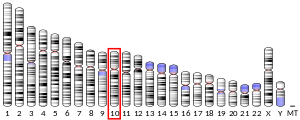Pancreatic polypeptide receptor 1
Pancreatic polypeptide receptor 1, also known as Neuropeptide Y receptor type 4, is a protein that in humans is encoded by the PPYR1 gene.[3][4]
| NPY4R | |||||||||||||||||||||||||
|---|---|---|---|---|---|---|---|---|---|---|---|---|---|---|---|---|---|---|---|---|---|---|---|---|---|
| Identifiers | |||||||||||||||||||||||||
| Aliases | NPY4R, NPY4-R, PP1, PPYR1, Y4, Pancreatic polypeptide receptor 1, neuropeptide Y receptor Y4 | ||||||||||||||||||||||||
| External IDs | OMIM: 601790 HomoloGene: 116086 GeneCards: NPY4R | ||||||||||||||||||||||||
| |||||||||||||||||||||||||
| |||||||||||||||||||||||||
| Orthologs | |||||||||||||||||||||||||
| Species | Human | Mouse | |||||||||||||||||||||||
| Entrez |
| ||||||||||||||||||||||||
| Ensembl |
| ||||||||||||||||||||||||
| UniProt |
| ||||||||||||||||||||||||
| RefSeq (mRNA) |
| ||||||||||||||||||||||||
| RefSeq (protein) |
| ||||||||||||||||||||||||
| Location (UCSC) | Chr 10: 46.46 – 46.47 Mb | n/a | |||||||||||||||||||||||
| PubMed search | [2] | n/a | |||||||||||||||||||||||
| Wikidata | |||||||||||||||||||||||||
| |||||||||||||||||||||||||
Selective Ligands
Agonists
- Pancreatic polypeptide
- Neuropeptide Y (endogenous agonist, non subtype selective)
- Peptide YY
- GR-231,118 (mixed NPY1 antagonist / NPY4 agonist, CAS# 158859-98-4)
gollark: Stuff, things, you know.
gollark: No. It doesn't sound like you would be very useful as a GTech™ GWorker™.
gollark: MattHowell?
gollark: What?
gollark: Huh?
See also
References
- GRCh38: Ensembl release 89: ENSG00000204174 - Ensembl, May 2017
- "Human PubMed Reference:". National Center for Biotechnology Information, U.S. National Library of Medicine.
- Lutz CM, Richards JE, Scott KL, Sinha S, Yang-Feng TL, Frankel WN, Thompson DA (Dec 1997). "Neuropeptide Y receptor genes mapped in human and mouse: receptors with high affinity for pancreatic polypeptide are not clustered with receptors specific for neuropeptide Y and peptide YY". Genomics. 46 (2): 287–90. doi:10.1006/geno.1997.5024. PMID 9417917.
- "Entrez Gene: PPYR1 pancreatic polypeptide receptor 1".
- Ziemek R, Schneider E, Kraus A, Cabrele C, Beck-Sickinger AG, Bernhardt G, Buschauer A (2007). "Determination of affinity and activity of ligands at the human neuropeptide Y Y4 receptor by flow cytometry and aequorin luminescence". Journal of Receptor and Signal Transduction Research. 27 (4): 217–33. doi:10.1080/10799890701505206. PMID 17885919.
External links
- "Neuropeptide Y Receptors: Y4". IUPHAR Database of Receptors and Ion Channels. International Union of Basic and Clinical Pharmacology.
Further reading
- Keire DA, Bowers CW, Solomon TE, Reeve JR (Feb 2002). "Structure and receptor binding of PYY analogs". Peptides. 23 (2): 305–21. doi:10.1016/S0196-9781(01)00602-7. PMID 11825645.
- Balasubramaniam A (Apr 2002). "Clinical potentials of neuropeptide Y family of hormones". American Journal of Surgery. 183 (4): 430–4. doi:10.1016/S0002-9610(02)00803-6. PMID 11975932.
- Parker E, Van Heek M, Stamford A (Apr 2002). "Neuropeptide Y receptors as targets for anti-obesity drug development: perspective and current status". European Journal of Pharmacology. 440 (2–3): 173–87. doi:10.1016/S0014-2999(02)01427-9. PMID 12007534.
- Benaim G, Villalobo A (Aug 2002). "Phosphorylation of calmodulin. Functional implications". European Journal of Biochemistry / FEBS. 269 (15): 3619–31. doi:10.1046/j.1432-1033.2002.03038.x. hdl:10261/79981. PMID 12153558.
- Lundell I, Blomqvist AG, Berglund MM, Schober DA, Johnson D, Statnick MA, Gadski RA, Gehlert DR, Larhammar D (Dec 1995). "Cloning of a human receptor of the NPY receptor family with high affinity for pancreatic polypeptide and peptide YY". The Journal of Biological Chemistry. 270 (49): 29123–8. doi:10.1074/jbc.270.49.29123. PMID 7493937.
- Bard JA, Walker MW, Branchek TA, Weinshank RL (Nov 1995). "Cloning and functional expression of a human Y4 subtype receptor for pancreatic polypeptide, neuropeptide Y, and peptide YY". The Journal of Biological Chemistry. 270 (45): 26762–5. doi:10.1074/jbc.270.45.26762. PMID 7592911.
- Yan H, Yang J, Marasco J, Yamaguchi K, Brenner S, Collins F, Karbon W (May 1996). "Cloning and functional expression of cDNAs encoding human and rat pancreatic polypeptide receptors". Proceedings of the National Academy of Sciences of the United States of America. 93 (10): 4661–5. doi:10.1073/pnas.93.10.4661. PMC 39335. PMID 8643460.
- Kawabe T, Muslin AJ, Korsmeyer SJ (Jan 1997). "HOX11 interacts with protein phosphatases PP2A and PP1 and disrupts a G2/M cell-cycle checkpoint". Nature. 385 (6615): 454–8. doi:10.1038/385454a0. PMID 9009195.
- Darby K, Eyre HJ, Lapsys N, Copeland NG, Gilbert DJ, Couzens M, Antonova O, Sutherland GR, Jenkins NA, Herzog H (Dec 1997). "Assignment of the Y4 receptor gene (PPYR1) to human chromosome 10q11.2 and mouse chromosome 14". Genomics. 46 (3): 513–5. doi:10.1006/geno.1997.5071. PMID 9441761.
- Hsieh-Wilson LC, Allen PB, Watanabe T, Nairn AC, Greengard P (Apr 1999). "Characterization of the neuronal targeting protein spinophilin and its interactions with protein phosphatase-1". Biochemistry. 38 (14): 4365–73. doi:10.1021/bi982900m. PMID 10194355.
- Smith FD, Oxford GS, Milgram SL (Jul 1999). "Association of the D2 dopamine receptor third cytoplasmic loop with spinophilin, a protein phosphatase-1-interacting protein". The Journal of Biological Chemistry. 274 (28): 19894–900. doi:10.1074/jbc.274.28.19894. PMID 10391935.
- Marx SO, Reiken S, Hisamatsu Y, Jayaraman T, Burkhoff D, Rosemblit N, Marks AR (May 2000). "PKA phosphorylation dissociates FKBP12.6 from the calcium release channel (ryanodine receptor): defective regulation in failing hearts". Cell. 101 (4): 365–76. doi:10.1016/S0092-8674(00)80847-8. PMID 10830164.
- Connor JH, Weiser DC, Li S, Hallenbeck JM, Shenolikar S (Oct 2001). "Growth arrest and DNA damage-inducible protein GADD34 assembles a novel signaling complex containing protein phosphatase 1 and inhibitor 1". Molecular and Cellular Biology. 21 (20): 6841–50. doi:10.1128/MCB.21.20.6841-6850.2001. PMC 99861. PMID 11564868.
- Cavadas C, Silva AP, Mosimann F, Cotrim MD, Ribeiro CA, Brunner HR, Grouzmann E (Dec 2001). "NPY regulates catecholamine secretion from human adrenal chromaffin cells". The Journal of Clinical Endocrinology and Metabolism. 86 (12): 5956–63. doi:10.1210/jc.86.12.5956. PMID 11739470.
- Cox HM, Tough IR (Mar 2002). "Neuropeptide Y, Y1, Y2 and Y4 receptors mediate Y agonist responses in isolated human colon mucosa". British Journal of Pharmacology. 135 (6): 1505–12. doi:10.1038/sj.bjp.0704604. PMC 1573267. PMID 11906964.
- Wu DY, Tkachuck DC, Roberson RS, Schubach WH (Aug 2002). "The human SNF5/INI1 protein facilitates the function of the growth arrest and DNA damage-inducible protein (GADD34) and modulates GADD34-bound protein phosphatase-1 activity". The Journal of Biological Chemistry. 277 (31): 27706–15. doi:10.1074/jbc.M200955200. PMID 12016208.
This article incorporates text from the United States National Library of Medicine, which is in the public domain.
This article is issued from Wikipedia. The text is licensed under Creative Commons - Attribution - Sharealike. Additional terms may apply for the media files.


